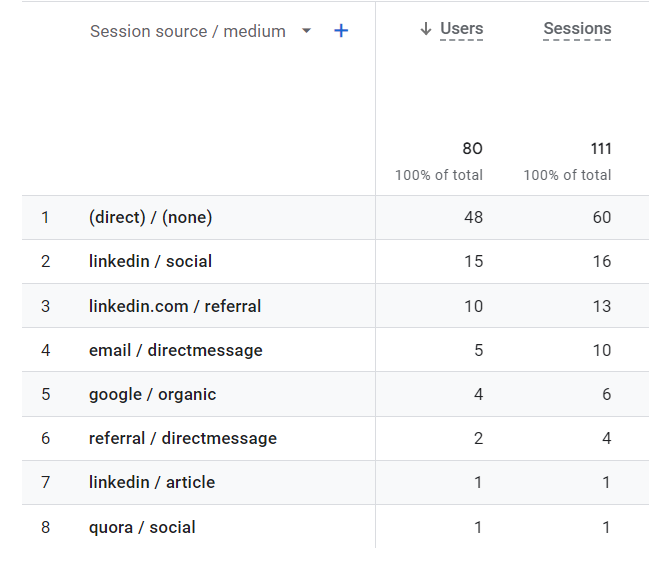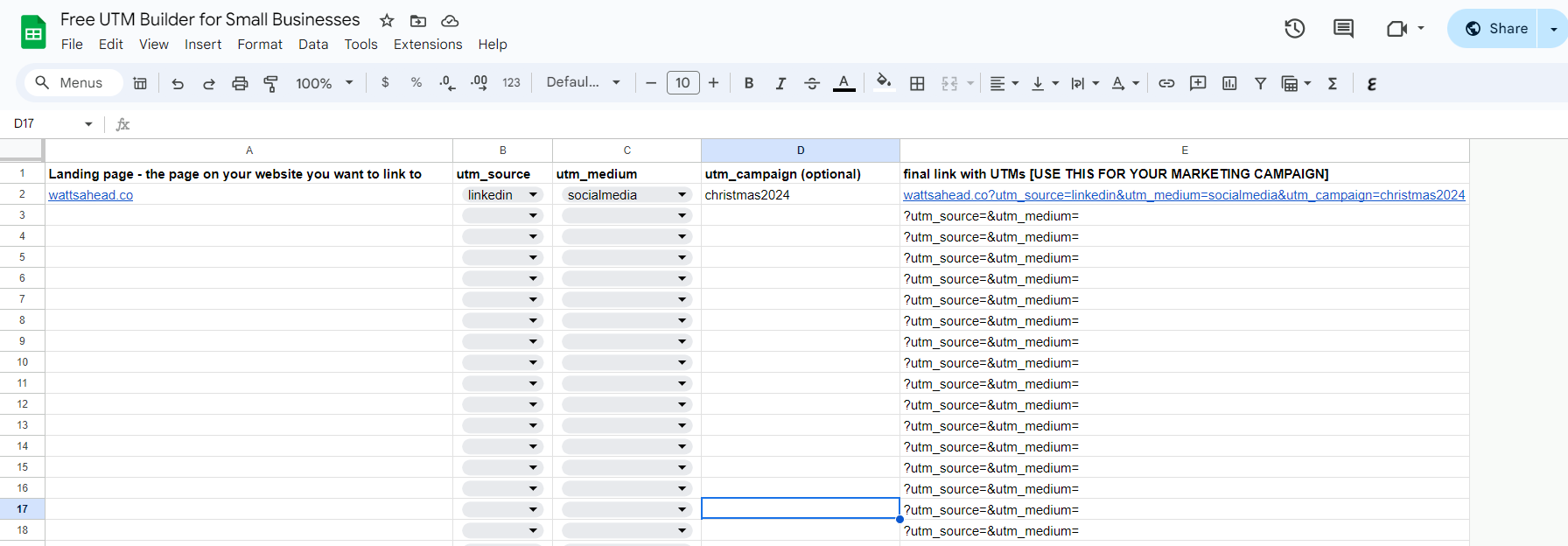How to Use UTMs to Measure the Success of your Digital Marketing Activity
So, you’ve made a website for your small business and you’re starting to get some visitors. But how do you know where your website traffic is coming from? UTMs are your answer. This guide will cover:
What Exactly is a UTM?
You might’ve heard the term “UTM” before and been confused. You might even have found out that UTM stands for “urchin tracking module” and been even more confused. But they’re super important and often misunderstood, misused or forgotten.
This is a sea urchin. It has nothing to do with Urchin Tracking Modules
Basically, UTMs are like tiny trackers you add to links that tell you information about the person visiting your website.
Consider an example: you’re a local tour company in Tucson, Arizona. You have a website that offers lots of different tour options in and around Tucson, Arizona. You’ve identified some great digital marketing channels you want to focus on: a TikTok account, an Instagram account, contributing expert info to local blogs, and running Google Ads for people searching for “things to do in Tucson”.
You only have one website, so you probably think you’ll just share www.tucsontours.com everywhere you’re active online. And there’s nothing wrong with that, you’ll hopefully get lots of visitors and you can continue doing marketing on blogs, TikTok, Instagram and running Google Ads.
Let’s say you got 1,000 visitors to the website after doing all your digital marketing activity. But what if all the effort you put into writing guest blog posts actually got you only 30 views, and running Google Ads got you 900 views?
That’s where UTMs can help. If you have UTMs on your links, you’ll be able to see how many visitors from each channel (or even each link if you want to be super specific).
Every time you share a link online, ideally you should include UTM parameters as part of that link.
What are UTM Parameters?
For this post, I’ll focus on the three most important UTM parameters: source, medium and campaign.
Source: This tells you where the click originated, like Facebook, Instagram, or a specific website (e.g., utm_source=tiktok). Imagine for Tucson Tours you post a special offer on a travel blog. The source parameter would be the name of that blog.
Medium: This tells you how the click happened, like email, social media post, or banner ad (e.g., utm_medium=email). Let's say you send an email newsletter about your Arizona hiking tours. The medium parameter would help you track how many people clicked the tour link from your email.
Campaign: This is where you get specific and tell us about the unique marketing campaign the link is part of (e.g., utm_campaign=summer-sale). So, for your summer sale on Arizona whitewater rafting trips, you could create a specific campaign parameter to track its performance.
How Do I Combine UTM Parameters to Make a Link?
When you create a link, as a minimum you should probably always have at least source, medium, and campaign parameters. To combine them, you have to follow this exact format:
[link to page on your website]?utm_source=[sourcename]&utm_medium=[mediumname]&utm_campaign=[campaign]
For example:
www.tucsontours.com?utm_source=facebook&utm_medium=bio&utm_campaign=christmaspromo
Note the ? after the initial URL and the & between each separate UTM.
How Do I Track the Results of Each UTM?
Firstly, you can only track UTMs to websites that you have access to the analytics for. I’ve had people in the past ask if we can add UTMs that go to an Instagram profile to measure where people are following the Instagram page from. Not possible.
I’m also going to assume you have Google Analytics set up for your website because you need it. Your website builder tool might have its own analytics and maybe can even track UTMs, but there’s no alternative for Google Analytics.
Inside Google Analytics (GA4), follow these steps:
In the left sidebar, click Reports
In the new sidebar, under Business Objectives, inside Generate leads, click Traffic acquisition
In the table underneath the chart, select the default breakdown, in this case Session primary channel group
Now you can choose the UTM breakdowns you want to look at, probably either source/medium (together) or campaigns. This is some of my source/medium data.
Why Do I Still Have So Much “Direct” Traffic in Google Analytics?
When you look at Google Analytics, I’d bet my life savings that “direct” is your top traffic source, even if you have perfect, consistent UTMs on every link you’ve ever posted. As you can see also in my example above.
It’s unfortunate, but it’s unavoidable.
“Direct” traffic includes:
People typing in your website name directly
Having your website auto-fill in search
People clicking from a bookmark they’ve saved
Missing/broken UTMs
“dark social” - sounds sinister, but this is just non-public social media, like direct messages through WhatsApp, Facebook Messenger, Telegram, etc. Most links here will be unattributed.
Tons more great info on direct traffic here: https://www.ruleranalytics.com/blog/analytics/direct-traffic-google-analytics/
Note that the link I just shared doesn’t have any UTMs so if you click it they’ll see it as “direct”. If you want to mess with their analytics, click the same link but with a UTM that might make them think they ran a marketing campaign with McDonald’s happy meals ☠️
https://www.ruleranalytics.com/blog/analytics/direct-traffic-google-analytics/?utmsource=mcdonalds&utmmedium=happymeal&utm_campaign=winterpromo
The Problems with UTMs
UTMs can tell you a lot about a website visitor, but they’re far from perfect. I’ve already mentioned a few of the problems, for example in the silly fake UTM example above. Here are just a few more problems:
Most of your traffic will be direct, unknown or otherwise unattributed
They break easily, because of issues with redirects, link-shorteners, browser extensions, etc.
They’re extremely easy to mess with, as with the fake link above. And as a digital marketer, I almost always check if a link I’m clicking has a UTM before I click it, and manually remove the UTM parameters before I click it. You won’t find out where I visited from if I can help it!
UTMs are digital-only. If you make a sale in-person, a UTM isn’t going to help you find out where that person heard of your company
UTMs are case-sensitive; utm_source=linkedin and utm_source=LinkedIn will show up separately in your analytics
UTMs are very difficult to maintain consistently
Maybe one UTM you attribute to utmsource=instagram and next time you do it as utmsource=ig by accident
What if different people on your team create UTMs differently?
What if you run two posts on the same channel as part of the same campaign, do you want to track them separately? If so, how? And how will you remember that format for next time?
But despite the problems, UTMs are still a hugely valuable tool for a data-hungry digital marketer (as all digital marketers should be).
UTM Best Practices
If you’re confused by everything I’ve said so far, it’s understandable. UTMs are hella confusing. But there are some best practices you can follow to make it easier:
USE LOWERCASE LETTERS always. No exceptions whatsoever. Not even if “LinkedIn” is actually supposed to be capital L and capital I.
KEEP IT SIMPLE. If your medium is email, your utm_medium=email. It’s not utm_medium=electronicmailingsystem
BE CONSISTENT with multiple word formatting (either no spaces or hyphens, not both!)
BE CONSISTENT across teams, across campaigns, across channels
TEST YOUR LINKS before you publish your link
USE A UTM BUILDER. Even if you’re a team of one and you only post on one channel, you’ll mess up very quickly if you manually type out a new UTM every time.
KEEP A RECORD of every UTM-ed link you’ve ever made, so you can check what you used in the past to help you be consistent
UTM Template Builder
Google’s UTM builder often gets recommended, but I actually don’t recommend it. If you just need one UTM it’s fine, but as far as I know it doesn’t store your past data, so it’s not going to help tell you stay consistent.
I’d recommend building your own UTM template builder in a spreadsheet. That might sound complicated, but it’s really not. A few columns of data and one concatenate formula and you’re ready to go, with a perfect UTM builder that also stores all of your previous links.
You can also use my free UTM builder template here with some basic source/mediums - just make a copy and you can use it. I highly recommend keeping the dropdown validation method and add new options to the source/medium as you need them; that way you’ll stay consistent.
Summary of UTMs
That was a lot of info, some of it quite technical, about a very misunderstood part of digital marketing. But a very important part. Using UTMs correctly can set you up for success by letting you measure the success of your individual channels’ performance.
If you have any questions or need help with setting up UTMs, post in the comments, email me, or message me on LinkedIn.
And if you found this post helpful, join the mailing list to never miss a new post.





